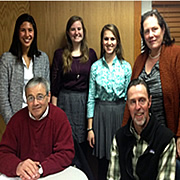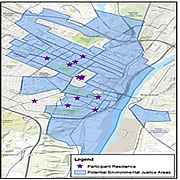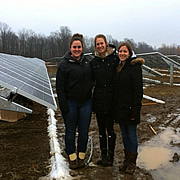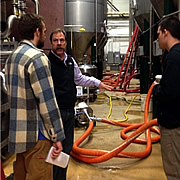
Senior Capstone Projects (2013-2014)
Rachael Bowen, Marie Nicol, and Will Conway (2014)
We investigated the identities and motivations of new farmers in the Hudson Valley to assess their potential political and economic impacts. Farmers had mixed reactions to their labeling as a social movement. Farmers shared a common love of the tangibility of farming and a common discontent with the current industrialized food system. They hoped to affect local economies, but were not motivated by the potential to alter the broader capitalist system.
Kate Brittenham, Max Conley, Will Blasini, and Margot Reisner (2014)
Human attempts to control nature through landscaping create problems. By working in conjunction with ecological cycles, sustainable landscaping practices can regenerate rather than degrade the environment. We compared the ecological impacts of traditional landscaping to the benefits of sustainable landscaping, and used other institutions as examples to develop a guide for best practices, costs and benefits, and a timeline for sustainable landscaping at Skidmore.
Elizabeth Cohen, Olivia Powers, and Kana Miller (2014)
The local food movement seeks to create an alternative food system to address social and environmental concerns by rejecting large-scale, industrial agriculture. However, because of its emphasis on consumer purchasing power, it is often criticized for being elitist. We attempted to characterize the local food community in Saratoga Springs, New York and deconstruct the ways in which social culture contributes to both its accessibility and inaccessibility.
Jack Marston, LJ Combs, and Rebecca Schwartz (2014)
Brewing beer is an energy- and resource-intensive process, from importing ingredients, through many phases of the brewing process, to distribution of the final product. Many craft brewers across the nation are attempting to mitigate their environmental impact. We investigated current sustainability practices and efficiency measures in craft breweries, and used the findings to inform an action research plan for Olde Saratoga Brewing Company, including feasible strategies to reduce energy and resource use.
 The End of Skiing?
The End of Skiing?
John Crisan and Andrew Blake (2014)
The first humans to strap long pieces of wood to their feet lived during the most recent Ice Age – 8000 BC. Today, skiing has become a way of life for some and declarations of its approaching demise have caused upset. We examined historic precipitation patterns, future climate and snow cover projections, and business theory to predict the effect of climate change on ski resorts.
Full report is not available. Please contact Karen Kellogg for more information.
 Public Participation in the Saratoga Springs Household Hazardous Waste Collection
Program: Community Based Action Research and Recommendations
Public Participation in the Saratoga Springs Household Hazardous Waste Collection
Program: Community Based Action Research and Recommendations
Jennifer Garvin, Faith Nicholas, and Lauren Schilling (2014)
We examined the current household hazardous waste (HHW) program of Saratoga Springs
in the hopes of enhancing participation and expansion. We researched other municipal
HHW programs in New York State and surveyed Saratoga Springs residents. Our study
led us to the following recommendations: utilize permanent facilities within the community,
hold collection days multiple times a year, and provide substantial educational material.
 Economic Growth, Politics, and Comprehensive Planning
Economic Growth, Politics, and Comprehensive Planning
Josh Inaba, Katherine Rosman, and Leslie Velasquez (2014)
Saratoga Springs is challenged with planning for future development that balances growth and conservation of natural resources. We conducted a historical and qualitative analysis of the city’s comprehensive plans over the last 50 years and interviewed various stakeholders, and studied how the theory of sustainable development has been implemented. Despite conflicts between competing interests, the outcome of comprehensive plans and the work of local politicians have balanced economic, sustainability, and social goals.
 Uncovering Environmental Injustice
Uncovering Environmental Injustice
Eliza Sherpa, Nicole Shepherd, and Janet Vidal (2014)
Literature on environmental justice (EJ) often fails to incorporate the perspectives of underrepresented communities most affected by environmental ills. Our research found differing definitions of EJ, a discrepancy between formal organizations and community groups in terms of which issues were top priorities, and an overall division between mainstream environmental movements and EJ communities. Repairing this divide will require place-based knowledge through community-based participatory research.
 Taking the (Sun) Initiative: An analysis of solar installations in New York’s Capital
Region
Taking the (Sun) Initiative: An analysis of solar installations in New York’s Capital
Region
Jenna Spooner, Caitlin White, and Anne Weis (2014)
Fossil fuels are the largest source of greenhouse gas emissions. We investigated the
incentives, challenges, and barriers to implementing commercial solar installations
at three sites in Saratoga Springs and Troy, and at Skidmore College, through research
and interviews. While financial incentives for solar projects are difficult to get
but necessary for implementation, the people behind these initiatives seem more interested
in their moral responsibility.
 Side Effects May Include: The impacts of trace pharmaceuticals and personal care products
on zebrafish (Danio rerio)
Side Effects May Include: The impacts of trace pharmaceuticals and personal care products
on zebrafish (Danio rerio)
Nonie Crossnohere, Joe Marto, and Julia Sabatino (2014)
Pharmaceuticals and personal care products (PPCPs) are becoming increasingly present
in U.S. waterways due to incomplete removal at wastewater treatment plants. This study
examines the effects of high concentrations of caffeine, fluoxetine, and 17-β-estradiol
on zebrafish. We found that while the zebrafish experienced increased metabolic stress
when exposed to concentrations of the compounds, they did not experience developmental
alterations that could influence survival.
Full report is not available. Please contact Karen Kellogg for more information.
 Fishing for Fishers: A biological corridor proposal for mid-sized mammals in Eastern
Upstate NY
Fishing for Fishers: A biological corridor proposal for mid-sized mammals in Eastern
Upstate NY
Alexandra Guest, Benjamin Greer, Dalton Weinstein, and Chris Antonez (2014)
Human development can fragment and degrade habitats. We propose a biological corridor
in Saratoga County, NY to mitigate the impact of habitat fragmentation on native species,
particularly the fisher. We found a positive correlation between basal land cover
and the presence of fishers, indicating the importance of forest conservation. The
existing landuse regime allows mid-sized mammals to disperse between Skidmore College
and Moreau Lake State Park and should ensure minimal loss of habitat connectivity
in the future.
Full report is not available. Please contact Karen Kellogg for more information.
 Understanding Disease Management and Farmers’ Perception of Soil Quality in a Rural
US Farming Community
Understanding Disease Management and Farmers’ Perception of Soil Quality in a Rural
US Farming Community
Tera Johnson, Aoife Semar, and Kate Jestin Taylor (2014)
Soil plays a critical role in supporting plant and animal life, but pathogens can
create diseases that result in crop loss and cause a cascade of negative effects.
We examined how fungicide management techniques influence soil dynamics and explored
how farmers get information to guide their management practices. Most local farmers
rely on the Cornell Cooperative Extension as their primary source of information.
Full report is not available. Please contact Karen Kellogg for more information.
 The Buzz on Beekman: An examination of New Urbanism at the neighborhood level
The Buzz on Beekman: An examination of New Urbanism at the neighborhood level
Kate Johnson, Emily Culbert, and Sarah Arndt (2014)
Examining urban revitalization at a neighborhood level provides a manageable scale
to assess whether development fosters relationships, builds community, and is sustained
through multiple generations. We used the Beekman Street neighborhood on the west
side of Saratoga Springs as a case study. Residents valued three key tenets of New
Urbanism – walkability, mixed-use, and density – but were concerned with potential
negative effects of increased commercialization.
Full report is not available. Please contact Karen Kellogg for more information.



